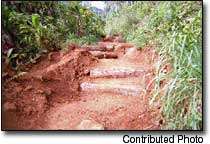When hiking to Hanakapi‘ai this summer, visitors and residents alike will be treated to spectacular views, beautiful flora, and… an easier walk? At least in certain spots, the two-mile trail from Ke‘e Beach on the North Shore to Hanakapi‘ai Beach
When hiking to Hanakapi‘ai this summer, visitors and residents alike will be treated to spectacular views, beautiful flora, and… an easier walk?
At least in certain spots, the two-mile trail from Ke‘e Beach on the North Shore to Hanakapi‘ai Beach will be easier to walk on, thanks to the state Department of Land and Natural Resources and the husband-and-wife team of Native Hawaiian trail-conservation experts, Charlie and Tanya Cobb-Adams.
The Kaua‘i branch of the DLNR, which hired the duo to do erosion-control work on one of the most heavily traveled hiking trails in the state, is gearing up for another busy summer.
“Ready or not, we have to deal with it,” said Wayne Souza, DLNR State Parks district manager.
According to a 2004 Hawai‘i Tourism Authority survey, over 500,000 people hike at least the first two miles or so of Na Pali Coast-Kalalau Trail every year. And with the summer tourist season upon us, a large chunk of those will be using the trail within the coming months.
And it will be a little easier for them.
The husband-and-wife team, along with a volunteer from Washington who just showed up on the trail and stayed for a week to help, put in water bars, log steps, retaining walls, and other erosion-control measures along “critical areas” near Hanakapi‘ai Stream, Charlie Cobb-Adams said.
Using only materials “borrowed” from the surrounding environment, mainly rocks and ironwood and guava trees, he added, the team concentrated on a handful of spots where the trail had been washed out, leaving mud patches.
The mud run-off can lead to a number of different problems, including mosquito infestation, ocean and stream pollution, the spread of harmful bacteria, damage to local fish populations, as well as making it difficult to walk, he added.
While the husband-and-wife team’s first priority was to the environment, they always build with an eye on safety, Charlie Cobb-Adams said. Hikers will be relieved to see how much easier it is to get through the reconstructed areas, he added.
“It was rough on us, but exciting,” he added.
The husband-and-wife team luckily avoided soaking rains that would have made their work harder during the 10-day project, but humid conditions and lack of tradewinds in mid-May caused Tanya Cobb-Adams a few heat headaches and some dizziness at some points, she said.
Their work, which involved cutting and heaving logs over 100 pounds, some over 200 pounds, into position, and then hammering them into place, all by hand, was extremely strenuous, they said.
But the appreciation from the hikers going by was an added bonus.
“Every person (that went by) said ‘thank you,’” Tanya Cobb-Adams said. “It was exciting.”
Some professionals in the field, from the National Park Service and the U.S. Forest Service, even applauded their work, the husband of the team said.
“When you get compliments from people that know trails, it means (a lot) to us,” he added.
Souza said Thursday that he hopes to put a similar project out to bid in fiscal year 2005, which begins July 1. This year, the money came from the State Park special fund, which is fueled by money generated from use of parks. He said that he expects the money will be available again this upcoming fiscal year.
The repair of the trail to Hanakapi‘ai is just one of many projects the public will be seeing in the upcoming months, Souza said.
One of the biggest changes will be repaving Koke‘e Road, the state road in Koke‘e State Park, which is expected to begin in September, Souza said.
Sewage and facilities improvements to Koke‘e and Wailua River State Parks have also been funded, as well as “a whole bunch of ADA barrier-removal projects,” he said of work to comply with the federal Americans with Disabilities Act.
State officials are also working with Koke‘e Museum leaders to make some trails in Koke‘e more “user-friendly,” he added. The project, for which the Koke‘e Museum received a grant, will make the trail heads for the Canyon Trail and the Water Tank Trail more accessible, he added.
Staff Writer Tom Finnegan may be reached at 245-3681 (ext. 252) or tfinnegan@pulitzer.net.


